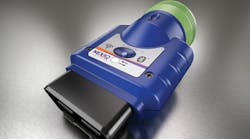I recently I had the opportunity to tour the newly renovated TEC Equipment truck and trailer dealership in Fontana, California. General Manager Mike Reardon gave an all-access tour that provided some insights into the daily operation of this impressive facility.
In 1976, TEC Equipment Founder David Thompson began building his business in Portland, Oregon, by selling one used truck, followed by a few more, before buying a one-bay garage. The operation now includes 26 locations and is still growing, spanning five states in the western U.S.
Officially opened in June, the certified Mack, Volvo and Wabash dealer operation spans 174,000 sq. ft. on 14 acres, with a capacity to service 102 Class 8 trucks at one time. To put this in perspective, from the front door to the back door spans the distance of two football fields. That’s not including the used truck facility and collision center. There are 400 truck parking spaces, and 50 spots for 53’ trailers. Each parking spot is numbered for easy identification of the assets on premise.
The facility currently employs 164 individuals, and has an auditorium and dedicated 44,000 sq. ft. training area to hold train-the-trainer and VIP educational sessions for personnel.
I was particularly impressed with the setup and process for the parts warehouse, the service command center and the shop floor.
Parts warehouse
Technically, there are two parts warehouses accounting for 2.2 acres of the location’s 14 acres, containing $5 million worth of parts. Reardon confirmed parts turns average five to six times per year.
Upon initial delivery of the parts, every part is scanned for inventory and barcoded for tracking.
Reardon explained the Fontana dealership stocks parts in two different places to be more efficient. The larger warehouse downstairs accounts for many of the larger parts – brake discs and drums, batteries, etc. The upstairs warehouse houses a number of smaller parts and duplicate parts already stored in the downstairs warehouse. Service center parts are also stored here.
Service command center and shop floor
Geofencing around the facility allows for more efficient review and repair of the vehicle throughout the entire service process. During the initial inspection, the service writer will download information from the truck, which is automatically sent to the service command center to assign to a technician.
The 2,000 sq. ft. glass-enclosed command center features a service dispatch with five mobile service trucks available when needed. The service center coordinates repairs and service for customers and assigns them to the appropriate technician.
What was particularly interesting was how the service center was set up, and the process for technicians working the bay. The shop features drive-through bays, and is organized by type of work. Some of the designated areas include bays dedicated to just transmission work, chassis work, 16 double-bays for quick fix and uptime services (service that takes four hours or less), and two double-bays dedicated to alternative fuels such as electric and natural gas vehicles.
The entire shop floor is designed so trucks can drive through every bay to a center aisle that remains clear. Another interesting efficiency design: every other column has a programmable five-reel setup. Before service begins, the types and amounts of fluids (engine oil, hydraulic fluid, etc.) needed are determined in the service command center. Fluids are programmed and available to the technician to dispense when he or she needs them.
This location employs 51 technicians currently – 38 of them are ASE master technician certified. Technicians hardly, if ever, leave their bays while working on a vehicle. Every bay has a computer system where the tech can order parts right in the bay. The parts are brought directly to the technician by a runner (who will also bring back cores for remans, etc.).
Many larger fleets have terminals at this location, and also have the option to coordinate with TEC Equipment for quick pickup and delivery of vehicles and parts when needed.
Anywhere a shop can improve efficiencies, it can help the bottom line. It takes planning and forethought to improve upon processes and shop layouts. It’s exciting to see something like this in action.




